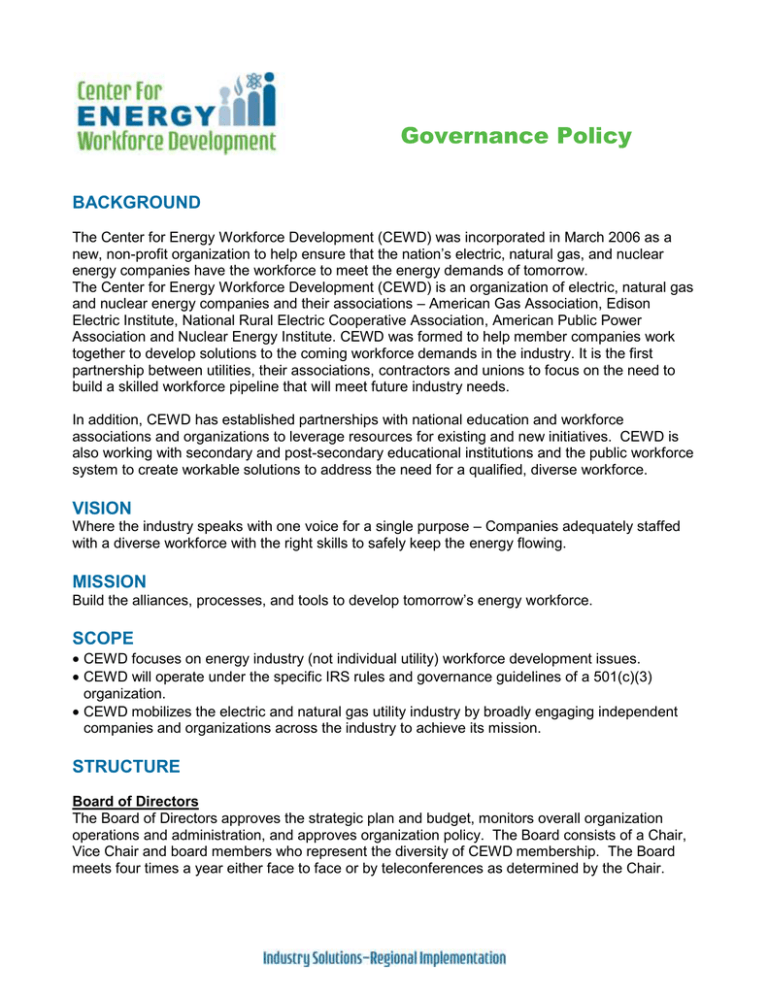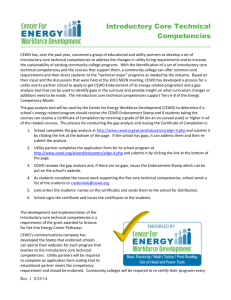CEWD Governance Document - Center for Energy Workforce
advertisement

Governance Policy BACKGROUND The Center for Energy Workforce Development (CEWD) was incorporated in March 2006 as a new, non-profit organization to help ensure that the nation’s electric, natural gas, and nuclear energy companies have the workforce to meet the energy demands of tomorrow. The Center for Energy Workforce Development (CEWD) is an organization of electric, natural gas and nuclear energy companies and their associations – American Gas Association, Edison Electric Institute, National Rural Electric Cooperative Association, American Public Power Association and Nuclear Energy Institute. CEWD was formed to help member companies work together to develop solutions to the coming workforce demands in the industry. It is the first partnership between utilities, their associations, contractors and unions to focus on the need to build a skilled workforce pipeline that will meet future industry needs. In addition, CEWD has established partnerships with national education and workforce associations and organizations to leverage resources for existing and new initiatives. CEWD is also working with secondary and post-secondary educational institutions and the public workforce system to create workable solutions to address the need for a qualified, diverse workforce. VISION Where the industry speaks with one voice for a single purpose – Companies adequately staffed with a diverse workforce with the right skills to safely keep the energy flowing. MISSION Build the alliances, processes, and tools to develop tomorrow’s energy workforce. SCOPE CEWD focuses on energy industry (not individual utility) workforce development issues. CEWD will operate under the specific IRS rules and governance guidelines of a 501(c)(3) organization. CEWD mobilizes the electric and natural gas utility industry by broadly engaging independent companies and organizations across the industry to achieve its mission. STRUCTURE Board of Directors The Board of Directors approves the strategic plan and budget, monitors overall organization operations and administration, and approves organization policy. The Board consists of a Chair, Vice Chair and board members who represent the diversity of CEWD membership. The Board meets four times a year either face to face or by teleconferences as determined by the Chair. Executive Council The Executive Council represents members, develops policy on organization issues, recommends the strategic plan and budget for approval by the Board, provides management guidance and oversight to CEWD operations, and provides support for the development of membership, partnerships, alliances, and sponsorships. The Council consists of a Chair, Vice Chair and Council members who represent the diversity of CEWD membership. The Council meets four times a year – one meeting is face to face and three meetings are by teleconferences. Executive Council membership – The council will have up to 15 members. The members will serve a 3 year term (staggered) and can be reappointed when the term has ended. CEWD officers and staff will nominate new members. The Chair and Vice Chair should mirror the Board of Directors. CEWD Officers and Staff CEWD officers and professional staff are responsible for day to day management of CEWD. MEMBER ADVISORY COUNCILS There is one standing member advisory council and other ad hoc councils or task forces that provide direction, support and advice to staff in the implementation of CEWD strategy and initiatives. The councils include member company representatives as well as outside subject matter experts and each standing member advisory council is chaired by a member company representative. Additional Advisory Councils or task forces may be established as needed based on the projects and initiatives approved by the Executive Council Workforce Planning Council The Workforce Planning Council provides guidance to CEWD on data and reporting to support the balancing of job demand and educational supply including the CEWD Gaps in the Energy Workforce survey, detailed supply and demand reports, and the analysis of alternate sources of data. The council also supports CEWD in the development of metrics to evaluate the success of workforce development efforts at the national, state and company level. MEMBERSHIP CEWD Energy Company and Association Members contribute financial resources. Full members of EEI, NEI, AGA, APPA and NRECA are eligible for energy company membership. Other companies, organizations and associations become members by Executive Council invitation. (A list of CEWD Members can be found in the Appendix) Non-utility firms eligible to join CEWD are either: Contractors and vendors performing work on site at a member utility or directly on a utilities transmission and distribution system such as system engineering, construction, operation and maintenance, equipment testing, refurbishment and repair, and customer service; or • Contractors and vendors performing work off site for a member utility, such as engineering modifications, component fabrication, equipment refurbishment, equipment manufacturing, and equipment testing. Partners have significant common interests, needs, objectives and goals and bring complementary skills and resources to the partnership. Partnerships are negotiated with agreement on specific outcomes and what each partner will provide along with fees or in-kind contributions. • • Secondary and Post Secondary Educational Institutions may become educational members by recommendation of a sponsoring member utility. Educational members agree to share information on curriculum, structure and results for individual programs. Workforce Systems and Government Agencies may become members by recommendation of a sponsoring member utility. Resources The administrative budget of CEWD is funded by member contributions. Initiatives are also funded through federal/state and foundation grants and/or corporate contributions and from other sources, such as meeting fees. The energy company member contribution schedule is as follows: More than 15,000 employees - $30,000 10,000 – 14,999 employees - $25,000 7,500 – 9,999 employees - $18,750 5,000 – 7,499 employees - $12,500 2,500 – 4,999 employees - $6,500 1,000 – 2,499 employees - $3,500 101 – 999 employees - $1,250 Under 100 employees - $750 The utility association member contribution schedule is as follows: National association contributions are negotiated. Regional associations - $6,500 Local / State associations - $1,250 The contractor member contribution schedule is as follows: More than $1 billion in U.S. Revenue - $30,000 $500 million - $1 billion - $25,000 $250 million - $499 million - $18,750 Less than $250 million - $9,000 Appendix BOARD OF DIRECTORS Geisha J. Williams, Chair Executive Vice President, Electric Operations PG&E Corporation Dr. Ralph Izzo Chairman, President and CEO Public Service Enterprise Group, Inc Elizabeth Reese, Vice Chair Executive Vice President, Chief Financial Officer AGL Resources Thomas R. Kuhn President Edison Electric Institute John Donleavy Executive Vice President & COO National Grid Paula Marino Senior Vice President, Engineering & Construction Services Southern Company Services, Inc. Jo Ann Emerson CEO National Rural Electric Cooperative Association Dave McCurdy President and CEO American Gas Association Marvin S. Fertel President and CEO Nuclear Energy Institute Robert Powers Executive Vice President & COO AEP Utilities, American Electric Power Thomas H. Graham Vice President People Strategy & Human Resources Pepco Holdings, Inc. Patti Poppe Senior Vice President, Distribution Operations, Engineering and Transmission Consumer’s Energy EXECUTIVE COUNCIL Laura Butler, Chair Vice President, Talent Management PG&E Corporation Elizabeth McAndrew-Benavides Senior Manager, Workforce Policy & Programs Nuclear Energy Institute Rebecca C. Meggesin, Vice Chair Vice President, Talent Management & Labor Relations Nicor Gas Susan Melians VP, Operations Services, Power Delivery Florida Power & Light Co Amy Best Sr. Vice President & Chief HR Officer Exelon Corp Margaret Pego Sr. Vice President & Chief HR Officer Public Service Enterprise Group, Inc Tracy Elich VP, Human Resources American Electric Power Michelle Rostom Director – Member Workforce Effectiveness National Rural Electric Cooperative Association Kathleen Geraghty Vice President, Labor & Employee Relations National Grid Douglas A. Staebler Vice President, Engineering & Construction Washington Gas Light Company Robert E. Grasty Director, Talent Management, Diversity & Inclusion Pepco Holdings, Inc. Leilani Todd Vice President, Human Resources Mecklenburg Electric Cooperative Debra Howell Workforce Development Manager Georgia Power Company Lori Traweek Sr. VP & COO American Gas Association Jim Hunter Director, Utilities Department International Brotherhood of Elec. Workers Deborah G. Zilai VP, Business Transformation & Technology New Jersey Resources Corporation Mike Langford President Utility Workers Union of America, Workforce Planning Council Debra Howell, Chair Workforce Development Manager Georgia Power Company CEWD OFFICERS AND STAFF Mary Miller, President CEWD Chief Administrative Officer, Edison Electric Institute Ann Randazzo, Executive Director, CEWD Elizabeth McAndrew-Benavides, Vice President CEWD Senior Manager, Workforce Policy & Programs Nuclear Energy Institute Carren Spencer, Program Manager CEWD Program Manager, Industry Human Resource Issues, Edison Electric Institute J. Bruce Brown, Secretary CEWD Deputy General Counsel, Corporate Affairs Edison Electric Institute Dana Berkheimer, Education Consultant Bradford Nixon, Assistant Secretary CEWD Assistant General Counsel, Edison Electric Institute Karl Christopher, Virtual Career Coach Terri Oliva, Treasurer CEWD Controller & Assistant Treasurer, Edison Electric Institute Mindy Feldbaum, Consultant Beth Britt, Consultant William Daniels, Education Consultant Ray Kelly, Consultant Andrew Schieffer, Administrative Assistant Rosa Schmidt, Consultant Julie Strzempko, Consultant Valerie Taylor, Education Consultant David Washington, Administrative Assistant Laura Williamson, Communications Consultant CEWD Members AGL Resources Alameda Municipal Power ALLETE Alliant Energy Ameren Services American Electric Power Company American Gas Association American Transmission Co. AREVA Arizona’s G & T Cooperatives Arizona Public Service (APS) Associated Electric Cooperative, Inc. Association of Illinois Electric Cooperatives Avista Utilities Bandera Electric Cooperative Basin Electric Power Cooperative Berkshire Hathaway Black Hills Corporation Bonneville Power Administration Central Hudson Gas & Electric Corp. Central Iowa Power Cooperative CHELCO Citizens Energy Group Cleco Corporation Coast Electric Power Association Colorado Springs Utilities Consolidated Edison, Inc. Consumers Energy Dominion DPL, Inc. DTE Energy Duke Energy Edison Electric Institute ElectriCities of North Carolina, Inc. Electric Cities of Georgia Energy Northwest Entergy Corp Eugene Water & Electric Board Exelon Corporation FirstEnergy Corp Great River Energy GreyStone Power Hawaiian Electric Company Iberdrola USA Idaho Power Company Indiana Statewide Association of Rural Electric Cooperatives Indianapolis Power & Light Inter-County Energy Cooperative JEA Kansas City Power & Light Knoxville Utilities Board Lakeland Electric & Water Utility Lincoln Electric System Luminant Madison Gas & Electric Co. Midwest Energy Association Montana-Dakota Utilities Mt. Carmel Public Utility Co. National Grid National Rural Electric Cooperative Association Nebraska Public Power District New Jersey Resources Corporation New York Power Authority NextEra Energy, Inc. Nicor Gas North Carolina Electric Membership Corp. NorthWestern Energy Nuclear Energy Institute OGE Energy Corp Omaha Public Power District Otter Tail Power Company Owen Electric Cooperative Pacific Gas & Electric Co. Pedernales Electric Cooperative Pepco Holdings, Inc. PNM Resources Portland General Electric PPL Corporation Public Service Enterprise Group Riverside Public Utilities Sacramento Municipal Utility District Salt River Project Santee Cooper SCANA Corp. Sempra Energy Utilities South Jersey Industries South Texas Proj. Nuclear Operating Co. Southern California Edison Company Southern Company Sulphur Springs Valley Electric Cooperation, Inc. Sumter Electric Cooperative, Inc. Sunflower Electric Power Corp. Tacoma Power Tennessee Valley Authority The Oglethorpe Family of Companies Tri-State Generation and Transmission Association, Inc. UGI Utilities, Inc. CEWD Partners • • • • • • • International Brotherhood of Electrical Workers Utility Workers Union of America Association of Career and Technical Education National Association of Workforce Boards National Energy Foundation American Association of Community Colleges Energy Providers Coalition for Education United Illuminating Co. UNS Energy Corporation Vectren Corporation Virginia, Maryland & Delaware Association of Electric Cooperatives Wabash Valley Power Association Washington Gas Light Co. WEC Energy Group Westar Energy Wisconsin Electric Cooperative Association Wyoming Rural Electric Association Xcel Energy, Inc. GUIDING PRINCIPLES FOR COMMUNITY COLLEGES AND OTHER EDUCATIONAL INSTITUTIONS The following are the guiding principles for educational institutions regarding membership in the Center for Energy Workforce Development (CEWD). Community Colleges 1. Educational institution must be sponsored by an energy company that is a member of CEWD. This sponsorship provides the educational institution with all of the benefits of a member. 2. Educational institution must share their curriculum or program with other CEWD members. 3. Educational institution must participate in curriculum development with industry consortia where appropriate such as state workforce consortia, Great Lakes Nuclear Consortium, etc. 4. Educational institution should participate with its energy partner in development of career awareness sessions at high schools and middle schools. 5. Educational institution should offer suggestions and programs to energy partner for attracting and recruiting students in middle and high schools. 6. Educational institution should work with energy partners and local high/vocational schools to create “dual enrollment” programs for students. 7. Educational institution should participate with its energy partner in sponsoring career awareness events such as: a. Lego leagues b. Robotic competition c. Science fairs d. Summer camps e. Teacher awareness/education 8. Educational institution should participate in the marketing and promotion of its programs to prospective students. 9. Educational institution should have personnel knowledgeable in the career opportunities in the energy industry to counsel prospective students. Middle school/high schools 1. Schools must be sponsored by an energy company that is a member of CEWD. 2. Schools should participate with its energy partner in sponsoring career awareness events such as: a. Mentoring b. Career awareness sessions c. Field trips d. Lego league sponsorship e. Robotics sponsorship f. Senior project in engineering g. Summer camps 3. Schools should work with their energy partner and local community college to create “dual enrollment” programs for students. 4. Schools should encourage their teachers to become more aware of the career opportunities in the energy industry. Criteria for CEWD Involvement in Projects and Initiatives Mission related - Project fits core mission of CEWD. Demonstrated need – the project will address a significant industry wide need as identified by CEWD members. Industry led initiative - Involvement requested by one or more member company(ies). Replication - Project will provide deliverable or results that can be leveraged or duplicated at minimum cost by CEWD members. Revenue neutral for CEWD - Project does not require substantial financial or resource investment from CEWD without compensation or leveraged funds.




